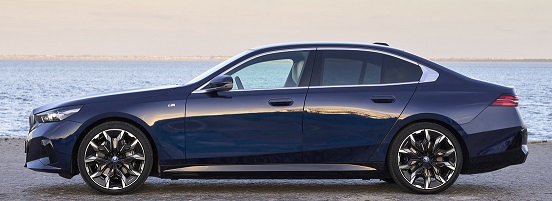Key specs
BMW i5 (Sedan) i5 Sedan (G60) 2023,2024,2025
What is the body type, BMW i5 Sedan (G60) 81.2 kWh (340 Hp) eDrive40 2023?
Sedan, 4 Doors, 5 Seats
How fast is the car, BMW i5 Sedan (G60) 81.2 kWh (340 Hp) eDrive40 2023?
193 km/h, Electronically limited 119.92 mph
How many cylinders, BMW i5 Sedan (G60) 81.2 kWh (340 Hp) eDrive40 2023?
Electric,
What is the drivetrain, BMW i5 Sedan (G60) 81.2 kWh (340 Hp) eDrive40 2023?
Rear wheel drive,
How long is this vehicle, BMW i5 Sedan (G60) 81.2 kWh (340 Hp) eDrive40 2023?
5060 mm
199.21 in.
How wide is the vehicle, BMW i5 Sedan (G60) 81.2 kWh (340 Hp) eDrive40 2023?
1900 mm
74.8 in.
What is the curb weight, BMW i5 Sedan (G60) 81.2 kWh (340 Hp) eDrive40 2023?
2130 kg
4695.85 lbs.
BMW i5 (Sedan) i5 Sedan (G60) 2023,2024,2025 Specs
General information
| Brand |
BMW |
| Model |
i5 (Sedan) |
| Version |
i5 Sedan (G60) |
| Engine version |
81.2 kWh (340 Hp) eDrive40 |
| Year production start |
2023 |
| Vehicle type |
Sedan |
| Acceleration 0 - 100 kmh sec |
6 sec |
| Curb weight kg -lbs total |
2130 kg
4695.85 lbs.
|
| Overall length mm - inch |
5060 mm
199.21 in.
|
| Doors |
4 |
| Top Speed |
193 km/h, Electronically limited 119.92 mph |
Engine specs
| Cylinders |
Electric |
| Weight / horsepower kg/hp - hp/tons |
6.3 kg/Hp
159.6 Hp/tonne
|
| Weight / torque kg/Nm - Nm/tons |
5 kg/Nm, 201.9 Nm/tonne
5 kg/Nm
201.9 Nm/tonne
|
| Fuel type |
Electricity |
| Powertrain architecture |
BEV (Electric Vehicle) |
| Electric motor power |
340 Hp @ 8000 rpm.
|
| Electric motor torque |
430 Nm @ 0-5000 rpm. 317.15 lb.-ft. @ 0-5000 rpm.
|
| Total available power |
340 Hp @ 8000 rpm.
|
| Totale available torque |
430 Nm @ 0-5000 rpm. 317.15 lb.-ft. @ 0-5000 rpm.
|
Transmission and Drive system
| Drive configuration |
Rear wheel drive
|
Brakes
| Front brakes |
Ventilated discs |
| Rear brakes |
Ventilated discs |
| Anti-lock brake system |
ABS (Anti-lock braking system) |
Steering
| Steering type |
Steering rack and pinion |
| Turning diameter m - ft |
12.3 m
40.35 ft.
|
Suspension
| Front suspension |
Double wishbone |
| Rear suspension |
Independent multi-link suspension |
Wheels & Tyres
| Wheels size |
245/45 R19 102Y XL
|
| Wheels rims |
8.5J x 19 |
Passenger
| Passengers seats |
5 |
| Trunk space min liter | cu. Ft. |
490 l
17.3 cu. ft.
|
| Roof load load kg lbs |
75 kg
165.35 lbs.
|
Dimensions
| Overall length mm - inch |
5060 mm
199.21 in.
|
| Overall width mm -inch |
1900 mm
74.8 in.
|
| Overall height mm -inch |
1515 mm
59.65 in.
|
| Wheelbase mm - inch |
2995 mm
117.91 in.
|
| Track width front mm - inch |
1616-1622 mm
63.62 - 63.86 in.
|
| Track width rear mm - inch |
1622-1658 mm
63.86 - 65.28 in.
|
| Coefficient of drag |
0.23
|
Weights
| Curb weight kg -lbs total |
2130 kg
4695.85 lbs.
|
| Gross weight kg -lbs total |
2740 kg
6040.67 lbs.
|
| Capacities kg - lbs |
610 kg
1344.82 lbs.
|
Engine type
Electric
https://www.thecarspec.com/components/engine/electric

